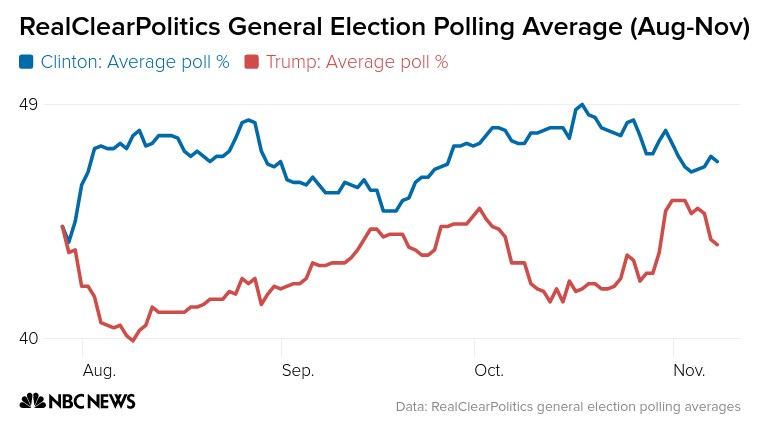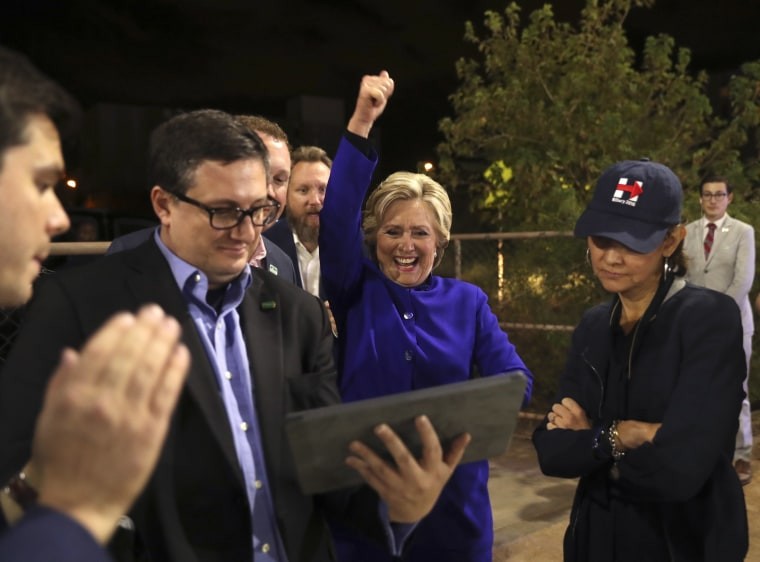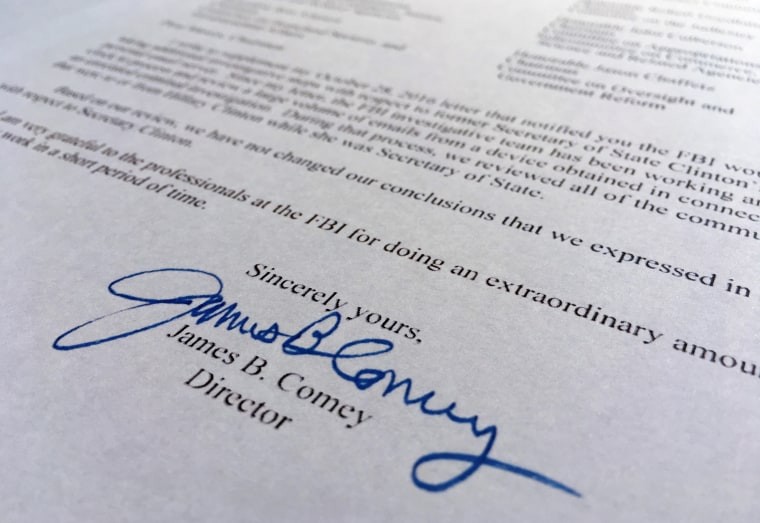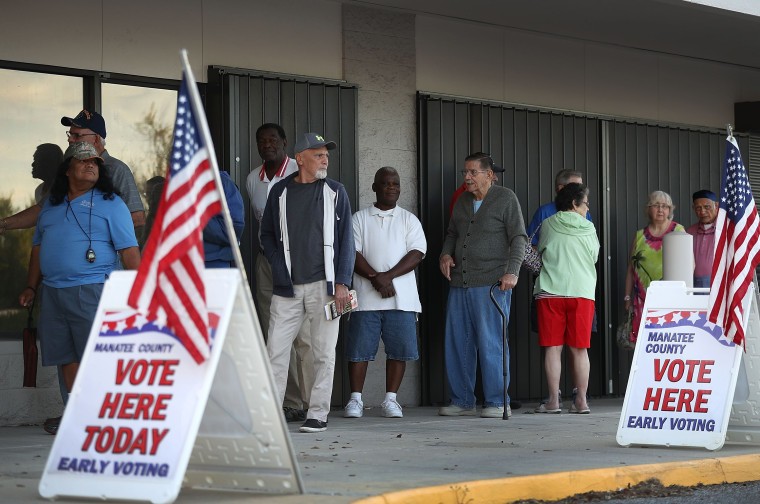Why Did Hillary Clinton Lose? Exploring the reasons behind her defeat in the 2016 presidential election is crucial to understanding the complex dynamics of American politics. This analysis by WHY.EDU.VN will delve into the critical factors that contributed to this unexpected outcome, providing clarity and insights. Discover potential explanations, impacting variables, and alternative perspectives.
Table of Contents
- The Unexpected Turn: The Final Days of the 2016 Election
- The Comey Letter: An October Surprise?
- Trump’s Disciplined Messaging
- Polling Inaccuracies: A Misleading Picture
- The WikiLeaks Impact
- The Second Comey Letter: Too Little, Too Late?
- Election Day Turnout: A Decisive Factor
- Underlying Volatility: A Key Factor
- Additional Factors Contributing to Hillary Clinton’s Loss
- Lessons Learned from the 2016 Election
- FAQ: Understanding Hillary Clinton’s Defeat
- Navigate the World of Knowledge with WHY.EDU.VN
1. The Unexpected Turn: The Final Days of the 2016 Election
The 2016 U.S. presidential election saw Donald Trump’s victory over Hillary Clinton in an outcome that defied expectations. Despite Clinton leading in the polls just weeks before Election Day, the race shifted dramatically in the final days. Several interwoven dynamics impacted the election results.
1.1 The Lead-Up to the Final Days
Hillary Clinton seemed poised for victory in late October 2016. The RealClearPolitics polling average showed her leading Donald Trump by nearly six points. State polls indicated leads in critical battleground states such as Pennsylvania and North Carolina. Even data analytics within the Trump campaign suggested a mere 15 percent chance of winning.
However, the apparent stability was deceptive. Both candidates were historically unpopular, creating an unstable political environment susceptible to sudden changes.
1.2 The October Surprise: The Comey Letter
The race took an abrupt turn on October 28, when then-FBI Director James Comey sent a letter to Congress. Representative Jason Chaffetz tweeted that the FBI was examining new emails potentially related to Clinton’s email server investigation. This announcement shifted the campaign’s focus, putting Clinton on the defensive for the remainder of the race.
This “October surprise” injected uncertainty into the election. It reignited questions about Clinton’s trustworthiness. Subsequent reports suggest that the emails in question came from Anthony Weiner’s laptop, the estranged husband of Clinton aide Huma Abedin.
1.3 The Impact of the Final Twelve Days
Several factors have been cited to explain why Hillary Clinton lost. James Comey’s intervention, Russian interference and WikiLeaks, Clinton’s absence in Wisconsin, lower African-American turnout, and Trump’s success among working-class white voters in the Rust Belt all contributed. However, the final twelve days were decisive.
NBC News interviewed numerous top Clinton and Trump operatives to understand what happened. There was an agreement that the volatility of the race combined with the way the final days unfolded created a most unexpected result.
1.4 The Clinton Campaign’s Perspective
Navin Nayak, the Clinton campaign’s director of opinion research, noted the race’s instability. “Unlike 2012 or 2008, there was a ton of instability in this race,” Nayak said. “If you were the person dominating the news, you went down.” Clinton’s lead expanded during negative news cycles for Trump but diminished during those for her.
Brian Fallon, the Clinton campaign’s national press secretary, acknowledged their vulnerability to an October surprise. The campaign was “living high on the hog of the ‘Access Hollywood’ tape.”
2. The Comey Letter: An October Surprise?
The FBI Director James Comey letter significantly impacted the 2016 election. The timing and ambiguity of the announcement reignited controversy over Clinton’s emails and private server, shifting momentum to Trump.
2.1 The Initial Impact
On October 28, Comey informed Congress that the FBI had discovered emails in an unrelated case, appearing “pertinent” to the investigation into Hillary Clinton’s personal email server. The lack of details in Comey’s letter exacerbated the uncertainty.
Comey stated, “Although the FBI cannot yet assess whether or not this material may be significant, and I cannot predict how long it will take us to complete this additional work, I believe it is important to update your Committees about our efforts in light of my previous testimony.”
2.2 Trump’s Response
Donald Trump quickly seized on the announcement. He used it to resurrect the months-long controversy over Clinton’s emails and private server.
Trump stated in New Hampshire, “They are reopening the case into her criminal and illegal conduct that threatens the security of the United States of America. Hillary Clinton’s corruption is on a scale we have never seen before. We must not let her take her criminal scheme into the Oval Office.” He repeated this message over the next eleven days, often met with “lock her up” chants.
2.3 Media Coverage and Public Perception
The Comey story dominated headlines and evening newscasts.
- The New York Times: “Clinton Works to Keep Trump and Emails at Bay”
- The Washington Post: “Get ready for four more years of Clinton scandals”
- The Los Angeles Times: “Is new scandal just like the old scandals? Controversies haven’t swayed voters much in the Clinton-Trump race. Email inquiry is the latest test”
- NBC’s “Nightly News”: “Email Review Underway”
- ABC: “FBI Searches Emails”
- CBS: “FBI Investigation”
Nearly half of the lead stories on the three broadcast network’s evening newscasts from October 28 to November 7 focused on Clinton’s emails.
2.4 Differing Perspectives on the Comey Letter’s Influence
Trump aides believed they gained ground after the third presidential debate when Trump focused on abortion and the Supreme Court. They also benefited from stories about rising Obamacare premiums. Comey’s letter added to this momentum. Matt Oczkowski, who directed Trump’s analytics team, said, “Comey brought these voters out of the woodwork. People had a reason to vote against Clinton.”
Kellyanne Conway, Trump’s campaign manager, offered a more tempered view. “The Comey letter may have been mildly helpful, but it did not lead to 306 electoral votes.”
Oren Shur, the Clinton campaign’s director of paid media, argued that “In the last two weeks, it was the only jolt to the system that occurred.” Nate Silver of FiveThirtyEight suggested it might have shifted the race by 3 or 4 percentage points toward Trump.
However, Nate Cohn of The New York Times was skeptical, noting that Clinton’s poll numbers had been declining before October 28. The American Association for Public Opinion Research concluded that evidence suggesting Comey tipped the election was mixed.
2.5 Clinton’s View
Clinton believed a different president would be in the Oval Office had the election occurred two weeks earlier. She stated, “If the election had been on Oct. 27, I would be your president.”
3. Trump’s Disciplined Messaging
In the final weeks of the campaign, Donald Trump exhibited a remarkable level of discipline in his messaging. This shift allowed his campaign to maintain focus on Clinton’s controversies rather than his own.
3.1 A Change in Tone
Trump refrained from the controversial attacks. He stopped attacking Alicia Machado, criticizing a Mexican-American judge, or asking Russia to find Clinton’s missing emails.
A top Trump campaign communications official noted, “He was remarkably disciplined down the home stretch. You could tell there was a light that went on — that we’re going to win this thing.”
3.2 Staying on Message
In Pensacola, Florida, on November 2, Trump said, “We are going to win the White House, gonna win it. Just —we’ve gotta be nice and cool, nice and cool. Right? Stay on point, Donald, stay on point. No sidetracks, Donald. Nice and easy.”
Trump fired off 138 tweets and retweets in the final twelve days without controversy. This allowed his campaign to concentrate on Clinton and away from his candidate.
3.3 Clinton’s Campaign Strategies
While Trump maintained his discipline, Clinton made a campaign stop in Arizona, a state that had not been a Democratic stronghold for years.
Clinton told 15,000 voters in Tempe, “This state is in play for the first time in years. Arizona has only voted for a Democrat for president once since 1948, and that was my husband in 1996.”
The Arizona trip aimed to regain momentum after the final debate. Clinton campaign officials considered proposing a fourth presidential debate and floated the idea of Joe Biden as her secretary of state to change the subject.
Jennifer Palmieri, the Clinton campaign’s communications director, said, “**What had concerned me greatly after the third debate was being [adrift] at sea. No moorings, no bearings, nothing to anchor yourself. The danger zone for us was always when there was nothing else going on in the race,”
4. Polling Inaccuracies: A Misleading Picture
Public and internal polling data leading up to the election presented an inaccurate picture of voter sentiment. This misrepresentation may have led the Clinton campaign to misallocate resources and underestimate Trump’s support.
4.1 Conflicting Poll Results
On November 3, polls showed Clinton up 4-5 points in Pennsylvania and narrowly ahead in Florida and North Carolina. A poll in Wisconsin showed Clinton leading Trump by 6 points.
NBC’s First Read concluded, “Team Clinton breathes sigh of relief, but they’re not in the clear yet.” However, Clinton would lose all four of those states on Election Day.
4.2 National vs. State Polls
The national polls were fairly accurate. The final RealClearPolitics average had Clinton ahead by three points. She won the national popular vote by 2 points, 48 percent to 46 percent, or nearly 3 million votes.
However, the state polls were a different story. Clinton’s internal polling had her up by about 6 points in Wisconsin. Internal Trump numbers also showed Clinton ahead in the state, albeit by a smaller margin. The Republican National Committee shared numbers with reporters showing Clinton leading in Florida.
4.3 Explanations for Polling Errors
Nayak of the Clinton campaign stated, “Everyone’s data was wrong — in the same direction — and that created a conventional wisdom that was off.” The reasons for these polling errors are varied and complex.
5. The WikiLeaks Impact
The release of John Podesta’s emails via WikiLeaks was another significant factor influencing the election. The revelations fueled negative headlines and contributed to a perception of Clinton as untrustworthy.
5.1 Revelations from Podesta’s Emails
The emails contained excerpts of Clinton’s paid speeches to Goldman Sachs, advisers’ candid criticisms of their candidate, and a memo on “Bill Clinton Inc.” These revelations fueled negative headlines and provided fodder for Trump’s attacks.
5.2 Trump’s Use of WikiLeaks
Trump frequently mentioned WikiLeaks at his rallies:
- October 31 in Warren, Mich.: “Did you see where, on WikiLeaks, it was announced that they were paying protesters to be violent, $1,500?… Did you see another one, another one came in today? This WikiLeaks is like a treasure trove”
- November 2 in Orlando, Fla.: “WikiLeaks just came out with a new one, just a little a while ago, it’s just been shown that a rigged system with more collusion, possibly illegal, between the Department of Justice, the Clinton campaign and the State Department”
- November 4 in Wilmington, Ohio: “Boy, I love reading those WikiLeaks”
NBC News counted 145 mentions of WikiLeaks by Trump in the last month of the race.
5.3 Impact on Voters
The WikiLeaks revelations, coupled with the email controversy, hurt Clinton. Top campaign officials believed voters couldn’t distinguish between the two.
Palmieri, Clinton’s communications director, stated, “People conflated WikiLeaks with Hillary’s emails.” Robby Mook, the campaign manager, added, “Benghazi, Comey, WikiLeaks all sounded like the same thing to voters.”
(Both Russia and WikiLeaks have denied that Russia was behind the 2016 hacks and email revelations.)
6. The Second Comey Letter: Too Little, Too Late?
James Comey’s second letter to Congress, issued just days before the election, further complicated the situation. While it cleared Clinton of wrongdoing, some believe it merely revived the email controversy at a crucial time.
6.1 The Contents of the Second Letter
“FBI Dir just informed us ‘Based on our review, we have not changed our conclusions that we expressed in July with respect to Sec Clinton,'” Chaffetz tweeted about the second letter Comey had sent to Congress.
The FBI’s investigation into the additional emails uncovered nothing new. Nearly all were duplicates of emails the agency had already seen.
6.2 Trump’s Reaction
Trump railed against Comey’s second letter, using it to re-litigate the email controversy. He told voters it was up to them “to deliver justice” on Election Day since no one else would.
Trump stated in Michigan, “Right now, she is being protected by a rigged system. It’s a totally rigged system…Hillary Clinton is guilty. She knows it. The FBI knows it. The people know it. And now it’s up to the American people to deliver justice at the ballot box on Nov. 8th,”
6.3 Clinton Campaign’s Perspective
The Clinton campaign initially saw Comey’s second letter as positive, suggesting Clinton was clear of wrongdoing. However, months later, officials believed it only revived the email story just before the election.
Shur of the Clinton campaign said, “At best, it hurt as much as it helped.” Palmieri added, “It just brought it all up again.”
6.4 Comey’s Rationale
On May 3, Senator Dianne Feinstein asked Comey why he made the initial announcement, given Justice Department guidelines against interfering in elections.
Comey stated he faced two options: speak about the emails or conceal them. He felt concealing them would be “catastrophic.” He added, “It makes me mildly nauseous to think that we might have had some impact on the election. But honestly, it wouldn’t change the decision.” Comey was fired six days after this testimony.
7. Election Day Turnout: A Decisive Factor
Despite positive early voting trends for Clinton, Trump significantly outperformed her on Election Day. This difference in turnout was a key factor in his victory.
7.1 Pre-Election Data
Leading up to Election Day, signs pointed to a Clinton victory. Early-vote numbers from Florida and Nevada looked promising. Final national polls boosted Clinton’s lead in the RealClear average above three points.
7.2 Election Day Shift
Trump defeated Clinton in voting on November 8, especially in key battleground states.
In Florida, nearly 70 percent of votes were cast before Election Day. Clinton enjoyed an estimated 4-point lead, about 240,000 votes.
Democratic strategist Steve Schale noted, “[Trump] won Election Day by 13 points.”
Exit poll data showed Trump winning those who decided in the last week by significant margins: 11 points in Michigan, 17 points in Pennsylvania and Florida, and 29 points in Wisconsin.
7.3 Final Assessment
The Trump team believed the final twelve days allowed them to achieve a significant political upset.
Oczkowski stated that their data showed Trump’s chance of winning increasing from 15 percent on October 27 to 35 percent by Election Day.
The Clinton campaign saw the final twelve days as their worst stretch. Jesse Ferguson, the Clinton campaign’s deputy national press secretary, said, “Campaigns have been told for years to expect the unexpected. But in this election we needed to expect the unbelievable, and we didn’t.”
Mook, Clinton’s campaign manager, concluded, “A lot of things came together to create what happened. We had a bunch of black swans that converged on us.”
8. Underlying Volatility: A Key Factor
Beyond specific events, the 2016 election was characterized by an underlying volatility due to the unpopularity of both candidates. This instability made the race susceptible to sudden shifts in momentum.
8.1 Unpopularity of Candidates
Both Hillary Clinton and Donald Trump were historically unpopular candidates. This meant that voters were more likely to be swayed by short-term events and controversies.
8.2 Impact of News Cycles
The Clinton campaign’s research showed that Clinton’s lead expanded during negative news cycles for Trump, such as the “Access Hollywood” tape, and shrank during negative news cycles for her, such as the Comey letter.
8.3 Susceptibility to October Surprises
The underlying volatility made the race more susceptible to October surprises, such as the Comey letter. These events had an outsized impact on voter sentiment because voters were already uncertain about both candidates.
9. Additional Factors Contributing to Hillary Clinton’s Loss
While the final days of the election were pivotal, a range of other factors also played a role in Hillary Clinton’s defeat. These include:
- Economic Anxiety: Many working-class voters felt left behind by the economic recovery and were drawn to Trump’s promises to bring back jobs.
- Globalization: The impacts of globalization, including job losses and wage stagnation, fueled resentment among some voters.
- Identity Politics: Trump’s appeals to white identity and cultural grievances resonated with some voters.
- Social Media: The spread of misinformation and fake news on social media may have influenced voters’ perceptions of Clinton.
- Campaign Strategy: Some critics argue that Clinton’s campaign strategy was too focused on demographics and identity politics, neglecting working-class voters.
10. Lessons Learned from the 2016 Election
The 2016 election offered several lessons for future campaigns and political observers:
- Polling is Imperfect: Polls can be inaccurate, especially at the state level.
- October Surprises Matter: Late-breaking events can have a significant impact on elections.
- Messaging is Crucial: Candidates need to stay disciplined and focused on their message.
- Turnout is Key: Campaigns must mobilize their base and persuade undecided voters to turn out on Election Day.
- Volatility is a Factor: Underlying volatility can make elections unpredictable.
Understanding these lessons can help campaigns navigate the complexities of modern elections and avoid the pitfalls that led to Hillary Clinton’s defeat in 2016.
11. FAQ: Understanding Hillary Clinton’s Defeat
Here are some frequently asked questions about why Hillary Clinton lost the 2016 election:
| Question | Answer |
|---|---|
| What was the Comey letter? | A letter from FBI Director James Comey to Congress announcing that the FBI was reviewing new emails potentially related to Hillary Clinton’s email server investigation. |
| How did the Comey letter affect the election? | It shifted momentum to Trump by reigniting controversy over Clinton’s emails. |
| Was polling accurate in 2016? | National polls were fairly accurate, but state polls were not. |
| What was the impact of WikiLeaks? | The release of John Podesta’s emails fueled negative headlines and contributed to a perception of Clinton as untrustworthy. |
| Why did Trump win on Election Day? | He outperformed Clinton in voting on November 8, especially in key battleground states. |
| Was the 2016 election volatile? | Yes, due to the unpopularity of both candidates. |
| What other factors contributed to Clinton’s loss? | Economic anxiety, globalization, identity politics, social media, and campaign strategy. |
| What are the lessons learned from the 2016 election? | Polling is imperfect, October surprises matter, messaging is crucial, turnout is key, and volatility is a factor. |
| How important was Trump’s disciplined messaging? | It allowed his campaign to maintain focus on Clinton’s controversies rather than his own. |
| Did Russia interfere in the 2016 election? | The U.S. intelligence community concluded that Russia interfered in the election, including hacking the emails of Clinton campaign chair John Podesta. |





12. Navigate the World of Knowledge with WHY.EDU.VN
Are you seeking answers to complex questions like, “Why did Hillary Clinton Lose?” Do you find yourself overwhelmed by the abundance of information online, unsure of what to trust?
WHY.EDU.VN is your reliable partner in the quest for knowledge. We provide detailed, easy-to-understand explanations backed by expert insights and credible sources. Our platform is designed to connect you with specialized information. We address your specific queries. Our experts cover topics ranging from historical events to scientific breakthroughs.
At WHY.EDU.VN, we understand the challenges of finding accurate and trustworthy answers. Our commitment is to provide you with thoroughly researched content, offering diverse perspectives and clear, concise explanations.
Need more answers?
- Ask an Expert: Have a burning question? Our experts are ready to provide tailored answers.
- Explore Our Library: Dive into our ever-growing collection of articles, covering a wide range of topics.
Join the WHY.EDU.VN community today and transform the way you learn. For any inquiries, reach out to us at:
Address: 101 Curiosity Lane, Answer Town, CA 90210, United States
WhatsApp: +1 (213) 555-0101
Website: why.edu.vn
